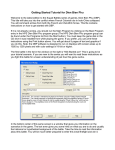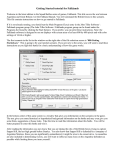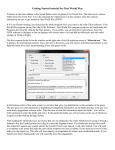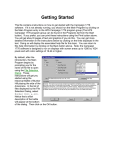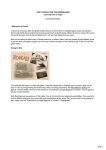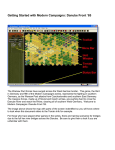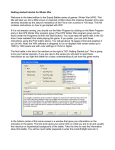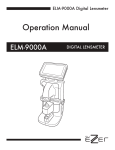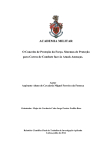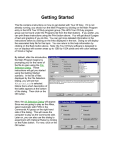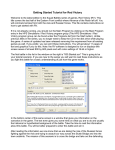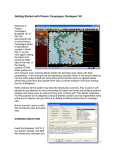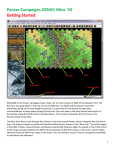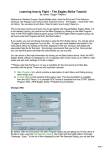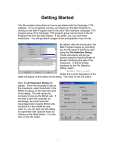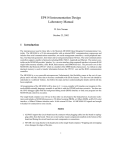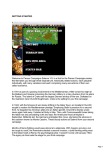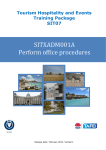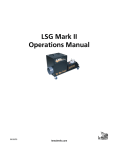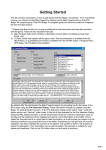Download Getting Started tutorial for Soviet-Afghan War
Transcript
Getting Started Tutorial for Modern War Welcome to the latest edition to the Squad Battles series of games, Modern War (MW). This title covers the two recent conflicts in Afghanistan and Iraq. You will command American forces in this scenario. This file contains instructions on how to get started with MW. If it is not already running, you should run the Main Program by clicking on the Main Program entry in the John Tiller Software \ Modern War program group (The John Tiller Software \ Modern War program group can be found under the Programs list from the Start button). Unlike older titles in the series, you no longer need to keep the CD in the disk drive while playing the game. A series of updates has been released removing this requirement from all existing games as well. If you prefer, you can print these instructions. You will get about 9 pages of text and graphics if you do this. Note: the MW software is designed to run on displays with screen areas of at least 800 by 600 pixels and with color settings of 16-bit or higher. The first battle in the list in the window on the right is "000.Started.scn" This is going to be your tutorial scenario. If you are new to the series you will want to read these instructions as you fight this battle for a basic understanding of just how this game works. In the bottom center of this same screen is a window that gives you information on the scenarios in the game. The text even gives you some hints on what you are to do and usually the historical or hypothetical background of the battle. Take the time to read the information about this battle. You will be better prepared to enter this battle and win it. After reading the information we now know that we are taking the role of the American forces fighting against the Iraqis and trying to drive them from a concrete building in the old port 1 area. The mission of this scenario is to cross the open ground and take out the defending strong points in the buildings with the objective hexes. Inflict as many casualties as possible, but it is also always a goal to limit your own casualties. Once you hit the enter key or click on "OK", you’ll see another menu of choices. This is the A/I Selection Dialog. In this menu you’ll pick which side you will be controlling. So choose "Manual" for the American A/I which means you will be controlling the American side. Next, click either on "Automatic" or "Automatic with FOW" for the Enemy side. Now the computer will control the Iraqi troops. "FOW" means fog of war. If you choose it, you won’t be able to see any enemy units until they come within the line of sight (LOS) of one or more of your units. Playing with FOW turned on makes the battle much more realistic and exciting as surprise and LOS are key elements of small unit actions. If you are, however, a first time player, it will be easier to play in "Automatic" without the Fog of War. Notice the word "Rules" at the bottom of the dialog box. Clicking on it will allow you to turn on or off the optional rules in the game. We’ll leave that alone for this time, but when starting future battles you can go in and select the optional rules that you desire. For more details on each rule click the “Help” button on that screen. After you have picked the method of play in the A/I Selection Dialog Menu, click on "OK". Since you are playing the Americans the Enemy side will go second. That may not always be the case, as sometimes the A/I player will go first. A box will appear designating which army has the turn; this box will appear at the beginning of each turn through out the game. You can either left-click on it to make it go away, and then repeat that each time, or you can right-click on it and it will display briefly then automatically go away each turn for the remainder of your session. Notice a small dialog box appeared once your turn started stating there is a Smoke limit of 35 for this scenario. Remember this as we’ll come back to it in a couple of minutes. For now just click the OK button. Now you see the battlefield and your troops. If you wish to scroll around the map with ease, click on the menu list at the top called "Settings" Then click on “Auto Scroll” unless it already has a check mark. Now you can simply run your mouse pointer to any corner of the map and the screen will move until the edge of the map is reached. For this scenario it isn’t a big deal as the map is so small, but in others it will be a big help. Your forces will be in view in the upper-left segment of the map, coming in across the field. This map is not that large, so depending on your screen resolution you shouldn’t have too much scrolling to do. You will see three objective hexes along the center of the paved area, 2 Southeast of your current position; these are the little boxes on the map with a number inside them. Holding these, along with eliminating the enemy are what you need to win the battle. The number is the points you earn when you capture the objective. Right now they all belong to the Iraqis …I’ll come back to those in a minute. If you want more information on objectives, strength or victory status, click on the “Info" menu at the top of the screen. Also, if you depress the “Shift” key you will see the label displayed denoting the names of the features on the map. If you want the names to stay on the map press the Alt key while pressing Shift. Press Shift again to remove them. Notice also that you can zoom in or out on the map with the keys "1" (2D Zoom Out) or "2" (2D Zoom In. Using the Zoom Out option lets us survey the map quicker and get that big picture. This allows you to be more aware of potential dangers and opportunities. You may also use the "+" and "-" buttons on the tool bar, or make your selection from the "View" menu. Take a careful look at your forces. Left click on any hex containing units and then look at the bottom of the screen. I chose the stack on hex 0,1 (you can find your hex numbers in the bottom right hand corner of the screen), and I see that within that hex I have a variety of infantry units and equipment. The hex info area to the right of your units displays the type of terrain your unit is currently in, the elevation and the visibility range currently active in the scenario. In this particular case we also see some red arrows on the right side of the display. This lets us know there are more units in the hex not currently being displayed. The number inside the arrow denotes that there are 10 currently hidden. These can be more mean, or possibly weapons. Using this simple procedure you can see information, weapons, status and a lot more on every one of your units. Right-clicking on the Information bar reveals other information about your units and especially their weapons such as: Reliability (Rel): Ranging from A (best) to F (worst) Range (Rng): Just how far the weapon will reach in hexes Lethality (Leth): The effectiveness of the weapon Penetration (Pen): This refers to the weapon’s ability to penetrate an enemy’s protection When the bar is right-clicked the info in the hex info area also changes, with the number displayed in the center being the total number of men stacked in the hex along with any special terrain features that might be present. 3 Also notice that at the bottom of the screen other pertinent information, such as the date and time of day, number of turns and weather conditions are given to you. Knowing more about what is going on, what your men can and cannot do, and the terrain you are in can be a big help to you in planning your tactics. If an error occurs during play, for example you try and give a unit a command it is not allowed to execute, then error messages will also display in this lower bar. In order to have proper tactics, you must know what your goals are. What are you trying to do here? Victory depends on a point difference. Points are acquired or lost in three ways. The first one is capturing (or holding) the objectives on the map. Doing so gives you points. There are other types of objectives, such as an "exit" objective. When used these will be objectives along the edge of the map with a ? on them. The army they belong to gets extra points if they move their forces to those hexes and then remove them from the map with the Command Menu at the top. In other scenarios, some objectives will be of the "Capture" type. Once you have taken them, the opponent cannot retake them. This type is represented in this scenario. There are three objectives in this battle, and your goal is to capture them from the Iraqis. Normally whoever controls an objective (the last one to move into the hex) at the end of the game will get the point value of the objective. In this case however the Iraqis get the points to begin with and you get them if you take the hexes at all. It should be noted that in many scenarios you can take and then lose objectives during the course of play, sometimes shifting from one victory level to another in a single turn. Victory conditions are usually tight in the Squad Battles games, so each and every piece of real estate is very valuable. The next way to get points is by destroying the enemy. You add to your final score for each enemy eliminated. They can often add up to more than the objective points. This means that you must create casualties on the other side in sufficient numbers to help you to get the points you need. And finally, you win by avoiding excessive losses. Remember the points for casualties work both ways. The computer or other human player will get points for losses that you suffer. Thus it is very important that you try to preserve your force while taking out the enemy. If you remain aware of these three factors you will have a better game with a better final score. Treat your force like they are real men under your command...don't send them on suicidal charges and you will stand a better chance of keeping your losses low! It should also be noted that in some scenarios “asymmetric” scoring is used – so American forces will be worth more than the enemy ones – so cause for extra care. In this game there are a series of what are called Hot Keys. These are keys that you can press during the game that will allow you to facilitate many of the features included. Practice using them and you’ll find that they will soon become second nature to you. A complete list of these keys can be found in the Main Program Help File by pressing F1 in the game, or going to the “Help” menu and making the appropriate selection. With this information it is time to go into action. Much of what I am going to mention now is already thoroughly covered in the User’s Manual (press F9 or go to the “Help” menu), but I’ll help you out a bit here so the play can get underway. Let’s take stock of our force & situation first. By clicking on the four hexes containing our force we find that we have a lead M-1 tank followed by some infantry. We also see the buildings on the other side of the railroad tracks 4 to our Southeast. So, our immediate goal is to approach the buildings, try to discover what sort of enemy presence is in them and start formulating our assault plans. But how do you move a unit? There are two ways. First make sure the button (with the cross hairs) at the top far left is not depressed. You depress it to fire. Go ahead. Try it. Now un-depress it so that you can move and not waste shots firing into thin air. You may also toggle to and from fire mode by pressing and holding the "Ctrl" key; if you just want to fire one unit and then go on to move others. Remember that each unit is always either in "fire" mode or "move" mode. Right now we want to move. You can do that in two ways. You can highlight the unit (double clicking on it) or units in a hex then right click in an adjacent hex. The highlighted unit(s) will move there. You can keep doing that until your unit runs out of movement points (MP). The other way is to highlight the units in the hex and then while holding down the left mouse key, go to the desired hex and release the key (Drag-and-drop). Try it. Look for the unit in hex 2,1. That would our M-1 tank. We are going to move it. Highlight the unit by double clicking with the left mouse key on the hex. Notice how the background lights up at the bottom of the screen. Now right click on hex 3,2 (to the right from where your unit is). Remember you can left click on any hex and nothing will happen. Doing that will help you find hex 3,2. If you do that, however, you’ll have to go back to 2,1 and highlight the unit again. Okay, with the unit highlighted, simply right click on hex 3,2. Notice that the arrow appears behind the unit so you see where you have moved from and your direction. Let’s move again, this time using the second method. Double click on the unit in hex 3,2. This time hold down the left mouse key after the second click. Now move your mouse over hex 5,3 (clear hex just to the right of the tracks) and release the key. Your unit will move into the hex. This is the “drag and drop” method of movement. In most cases you will want to move along the roads so you expend the least amount of movement points possible for each hex moved. Obviously that isn’t always possible, as in our current situation – but do keep in mind that each action, be it movement, changing facing location, or firing will cost you movement points on your unit. Be cautious in your movements…if your forces get caught marching down the road they can be decimated in a few short minutes. Use scouting elements and cover as much as possible when moving from point to point. So let’s take our current position, with our tank at hex 5,3. Go up to the toolbar and depress the “-“sign to zoom out (or use the hot key) and then depress the “Visible Hexes” button, or press “S”. This shades all the hexes we do not have a line of sight (LOS) to giving us an idea of what our tank commander can see. We can see that some of the buildings are not yet within our LOS. You can also press “C” (or use the button) to see the reachable hexes, or 5 how far your unit can move this turn with its remaining movement point allotment. Note however that not all units can move the same distance through the same terrain. The condition of a unit and sometimes the equipment it is carrying will impact how far it can move. Our chosen gives a decent view of most of the buildings. I did not draw any fire, so I am going to assume that it is safe to move the remainder of my column up – however I am going to move them due East to try and take advantage of those buildings as cover, rather than moving across the open field. One element that is vital to your success is your leaders. All three of the infantry unit stacks contain a leader (note the star on his counter image off to the left). He has special qualities. His purpose is to keep the men in good order during combat. Do not risk your leaders by putting them too far up front. Place them instead in positions of less danger but readily available to aid the men. For example, these leaders are stacked with various squads. Should it be fired upon and become "pinned" or "demoralized," it will be his responsibility to rally those troops. Without the presence in the hex of a leader, rallying troops is more difficult and takes much longer. Remember that dialog box we got at the beginning of the scenario about smoke? Well its time to look back at that. Some scenarios offer off-map “support” for your on-map forces. To access this we want to locate a leader that is in the same hex as a radio. Check the help file for more details on how to use off-map support. For our circumstances we have smoke ability on our tank. We can choose to deploy some of this to cover the movement of our troops. Once smoke is fired it stays active in the hex for a single round, a turn for each player, then it is considered to have dissipated. Go ahead and move the rest of your forces into place. Note for scenarios using raod movement - if you move your units one at a time they will be able to drive along the road for a period of time, thereby expending less movement points. However if you move an entire stack at once you do not benefit from the road movement cost but pay the full “clear” hex cost, or whichever terrain you are moving through. Be sure and review all the buttons on the toolbar by simply moving your mouse slowly across them. What each one does will be shown in a small white box. Here are a few points to keep in mind while moving your forces: a) b) c) d) Take advantage of the surrounding terrain…in this case high grass and later buildings. Get into hexes that will provide you cover and make it more difficult for the enemy to hit you. Make sure you have good LOS so you can see the buildings and detect any enemy movement that takes place. Along this same line, create overlapping fields of fire – so no one unit is on its own in defense. You want your men to support each other as this will give them the best chance for survival. As much as possible, maintain a reserve…so you have reinforcements to throw into a trouble spot…and watch your flanks! You are the attacker, so you will determine the primary points of action, but you need men left to exploit any advantage you gain. In most circumstances it is recommended that you complete your turn with your infantry in “on ground” mode, or prone. This makes them far less 6 vulnerable to fire on the next enemy turn. This can be done by selecting a unit with a double left click and then clicking on the "toggle ground" button in the menu icon section. This is the icon with the narrow white strip at the bottom. Once you do that, the selected units will then have a narrow white line at the bottom of their icon indicating their state. It will also be written on them in the unit list. You can also use the "0" key on the number pad to perform this action. Note that no points are expended when going to ground, however 3 MP's are required to stand back up. Once you have completed your moves go ahead and end your turn by pressing on the clock (Next Turn) button at the top of the screen when you have moved all your units. When the "Save as" screen appears give your game file a name and then click the "Save" button. Now the Iraqi forces have their turn and once that is complete your turn dialog box will again appear. Repeat this process as you move your forces into position and begin to respond to the enemy as they reveal themselves. Remember what I said about using covering terrain as well. Notice that when your troops come into sight and range of the enemy their units will use what is called "opportunity" fire. Your forces will do this too during the AI's turn. They will fire on the enemy automatically as they have the opportunity. As you advance towards the enemy your troops will begin to take fire from the units guarding the approaches to the buildings. You will note that as your units take fire they will often go "on ground", which is the natural reaction when someone is shooting at you! Keep this in mind when you go to move those units on your next turn, as a unit On Ground expends MP differently than one that is walking upright. Reinforcements! This is great news when they come… but for this scenario we don’t get any. It’s an important point to cover though, so while we are waiting for the enemy to revel their defensive positions I thought I would do so. You will be notified at the beginning of your turn when reinforcements do arrive. You have to click them onto the map to actually begin to use them however. To bring them on the map select the "Arrived Units" button on the tool bar and a new box appears listing your reinforcements. Highlight the unit and click "OK". Now they appear on the map and can be controlled like all the rest of your forces. In this scenario as with most SB scenarios, time is of the essence. You must continue to move your men so that they can be in a position to accomplish the scenario objective prior to the end of the allotted turns, so make every move count. A note on firing...when you fire you can either select all the units in a hex and have them all fire all their weapons at one target hex, or you can be selective and fire different weapons at different targets, or choose not to use some weapons at all, to conserve their effectiveness. If you wish to be selective use the Information bar to choose the weapons you want to use. Also, some weapons allow you to choose the type of load you fire. This is a critical point if you are advancing with tanks towards soft targets, such as infantry – which, to our knowledge, we are in this scenario. Shooting AP (Armor Piercing) rounds at infantry is going to be useless, so we want to 7 switch over to HE (High Explosive) to gain the greatest chance of inflicting damage on the smaller dispersed targets. To do this select the vehicle and then go to the “Command” menu and choose “Select Weapon Load”. You will then get a list of the options available to you for that particular weapon, which in this case is an 120mm main gun. As you play, you may find that some of the Iraqi troops are very hard to finish off with ranged (distance) fire. In that case, try an assault. An assault occurs when you attempt to move into a hex containing enemy troops. It is resolved automatically and winning it depends on a few things including the morale of your units, the types of weapons you have and the condition of the enemy units. I recommend that you initiate an assault with your troops in the prone position, as they tend to suffer fewer casualties that way. Assaults will be a big part of this scenario as the Iraqis try to hold the buildings and you try to take the objectives. I recommend trying assaults only if you feel your units are superior in number and state to those of the enemy units being attacked. Otherwise you may come out on the losing end. It can be very effective but it can also be a disaster for you. For example I have had a whole squad eliminated while assaulting a fortified position...a very painful loss to say the least! Soften the target up with support fire, grenades, satchel charges, etc. before you go in whenever possible. You should always try and limit your assaults to target units that have either been pinned or demoralized – your troops will fare much better. Continue your advance towards the buildings and try not to suffer too many losses. You can send your tank on ahead to clear the way, but don’t leave it alone without infantry support for too long, as it will not survive in close quarters without it. Make no mistake; this is a difficult mission that is before you. The chances of you suffering heavy losses before you even get to the target buildings is very high. The scenario is scored in such a way as it is possible for you to gain a victory, but not so you will gain one easily. Keep the pointers mentioned above in mind as you advance. Several turns in to the scenario I find my men pinned on the pavement with heavy fire coming from the buildings. Your situation may vary and you should act accordingly. You will continue the scenario from this point. You know how to see, move, shoot and assault. You have the basics. You are ready to do your own fighting. The more you play, the more adept you become as a commander. Many of the things we have mentioned here will become second nature to you. You’ll go from victory to defeat on occasion, but you will be learning and improving every time you play. When the scenario is over the Command Report will pop up with a message that the time limit is up. Clicking OK will then bring up the Victory Dialog. This box will show you the losses for both sides, the points awarded for Objectives captured, the Victory Values, Total Points scored and the Outcome. You can display the Victory Dialog at any time during the scenario from the Info/Victory menu item. This will allow you to follow your progress, but do not be alarmed to see that your side is losing, particularly in the early part of a scenario. Often the winning side is not determined until the last couple of turns. When vehicles are involved in a scenario the loss of them can radically affect the victory condition, so make sure you take care of your assets... 8 Feel free to save this battle and come back to it later if you want to do more exploring at this point. Whatever battle file you save can be given a name to identify it for later play. For example, you could name your file "first game" When you go back to the game simply click on "Open" from the file menu at the upper left, then click on the saved file. Hints are included in each scenario description, but you may also want to explore the various articles published on the Task Force Echo 4 site dealing with many aspects of tactical combat as it applies to this series. They can be found here: http://tfe4.wordpress.com/supply-section/tactics-articles/article-archives/ All the members of this Modern War design team want this to be the start of many exciting gaming hours for you as you fight your way through the battles and campaigns included in this game. And don't forget...while the AI is a solid player in the Squad Battles series and can be quite a challenge, there's no substitute for a game against a real person. So adventure out on to the web and explore the on-line resources that exist to support this and the other JTS games when you are ready. This web page will help you get going: http://www.hist-sdc.com/hps/opponents.htm What's new? For returning players to the Squad Battles series there have been a few engine enhancements and additions to make the game series more enjoyable. They are listed below: 1) Added the ability for alternate graphics to be pulled, by placing them in the \Info\Alt\Units.bmp, \Map\Alt\2DUnits*.bmp, and <nation>\Alt folders (where <nation> refers to any nation folder in the game). 2) Suicide weapons such as VBIED’s & vests. 3) Collateral hexes to simulate damage against non-military targets. 4) Altered the assault logic to calculate leader & unit values separately. 5) Variety of new modern weapons, such as the XM-25. For updates, downloads and the latest information visit JTS at http://www.johntillersoftware.com or email [email protected] . 9









